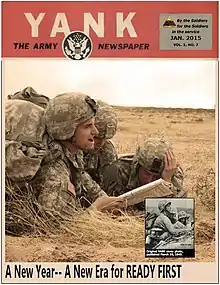 Yank, The Army Weekly, April 13, 1945 Cover art of Rifle Company Medic by Sgt Howard Brodie | |
| Frequency | Weekly |
|---|---|
| First issue | June 17, 1942 |
| Final issue | December 28, 1945 |
| Company | United States Army |
| Country | United States |
| Based in | New York City |
| Language | English |


Yank, the Army Weekly was a weekly magazine published by the United States military during World War II.
History
The idea for the magazine came from Egbert White, who had worked on the newspaper Stars and Stripes during World War I. He proposed the idea to the Army in early 1942, and accepted a commission as lieutenant colonel. White was the overall commander, Major Franklin S. Forsberg was the business manager and Major Hartzell Spence was the first editor.[1] White was removed from the Yank staff because of disagreements about articles which had appeared.[2] Soon afterward, Spence was also assigned to other duties and Joe McCarthy became the editor.[3]
The first issue was published with the cover date of June 17, 1942,[4] as a 24-page weekly tabloid, with no ads, costing five cents.[5] The magazine was written by enlisted rank (EM) soldiers with a few officers as managers, and initially was made available only to the US Army overseas.[6] By the fifth issue of July 15, 1942, it was made available to serving members within the US, however it was never made available on the newsstands for public purchase.[7] Yank's circulation exceeded 2.5 million in 41 countries with 21 editions.[8]
The last issue was published on December 28, 1945.[9] Joe McCarthy remained the editor of Yank until the official closure of the office on New Year's Eve 1945.[10]
Trimmingham letter
The magazine's April 28, 1944, issue included a letter from a black corporal, Rupert Trimmingham, complaining that white German prisoners of war were being treated with more respect than black American soldiers.[11] The reaction to the letter was strong and immediate. In a follow-up letter published 28 July 1944, Trimmingham said that he had received 287 letters, 183 from whites, supporting his position. The editors reported that Yank had received "a great number of comments from GIs, almost all of whom were outraged by the treatment given to the corporal."[12] The same year, the letter inspired a short story by Robert E. McLaughlin, "A Short Wait between Trains,"[13] and in 1945, a one-act play by Ruth Moore.[14]
Artists and photographers
Sketch artists such as Robert Greenhalgh,[15] Victor Kalin and Howard Brodie worked on the magazine, which also featured the "G.I. Joe" cartoons by Dave Breger and the Sad Sack cartoons by Sgt. George Baker. The cartoons of The Family Circus creator were featured in Yank, and artist and author Jack Coggins spent over two years with the publication, first in New York, then in London, producing illustrations and articles in more than 24 issues.[16] John Bushemi was a photographer, who photographed the Pacific War and provided covers for Yank.[17]
Revival
In 2014, the 1st Stryker Brigade Combat Team, 1st Armored Division, Fort Bliss, Texas, revived Yank as the official publication for the brigade. Each cover of the 1/1 Yank features soldiers from the brigade recreating a cover photo from the original Yank magazine.[18]
See also
References
- ↑ McGurn, Barrett (2004). Yank the Army Weekly: Reporting the Greatest Generation. Fulcrum Publishing. ISBN 1-55591-296-6. p. 65
- ↑ White, Egbert. "A Free Press in a Citizen's Army". Journal of Educational Sociology. 19 (4): 236–248. JSTOR 2263264.
- ↑ McGurn pp. 87–89
- ↑ McGurn p. 79
- ↑ "Yank Magazine Created a Unique Record of American Soldiers' Roles in World War II". HistoryNet. January 4, 2022. Retrieved May 26, 2023.
- ↑ McGurn p. 70
- ↑ McGurn p. 83
- ↑ McGurn p. 250
- ↑ McGurn p. 250
- ↑ McGurn p. 249
- ↑ Carroll, Andrew, ed. War Letters: Extraordinary Correspondence from American Wars (New York: Simon and Schuster, 2008), p. 315.
- ↑ Brinkley, Douglas, ed. The New York Times Living History: World War II, 1942–1945: The Allied Counteroffensive (New York: Harry Holt and Company, 2003) p. 176.
- ↑ McLaughlin, Robert. "A Short Wait between Trains" New Yorker 20:18, 14 June 1944, pp. 27–99.
- ↑ "Chi Legit Casts Do 1-Acters on 'Action' Stage." Billboard 57:42, (20 October 1945), p. 3; Dail, Chrystyna. Stage for Action: U.S. Social Activist Theatre in the 1940s (2016) Carbondale: SIU Press, p. 3.
- ↑ "They Drew Fire – Robert Greenhalgh". pbs.org.
- ↑ "Jack Coggins – Yank Magazine Illustrations & Articles". Retrieved January 6, 2018.
- ↑ "Operations Against the Japanese on Arundel and Sagekarsa Islands". World Digital Library. 1943. Retrieved June 2, 2013.
- ↑ "1st Brigade Combat Team, 1st Armored Division". Defense Imagery and Video Distribution System. Retrieved March 12, 2015.
External links
- "The Art of Yank Magazine: The World War Two Drawings of Robert Greenhalgh". Special Collections, Brown University Library. Retrieved February 13, 2013.
- "Yank". (Cover, February 20, 1944 issue, British edition) National Museum of American History. Retrieved February 13, 2013.
- "Army: Yank Magazine – All Editions". (Archive of select issues) Wartime Press. Retrieved February 13, 2013.
- Yank Magazine – Selected Editions - onlinebooks.library.upenn.edu
- YANK Magazine – All Editions – War Time Press
- search: site:www.ibiblio.org/hyperwar/NHC/NewPDFs/USArmy/ intitle:"Yank Magazine"
- McManus, Larry (January 7, 1944). "Random Notes on the Makin Operation". Yank, the Army Weekly magazine. p. 8.
Their CO, 1st Lt. Edward O'Donovan of Cohoes, N.Y., once a member of the AAF, has an easy answer to the debate about whether the Fubars are soldiers, sailors or marines; he says they're probably being carried as AWOLS in Washington. ...FUBAR? It means 'Fouled Up Beyond All Recognition.'